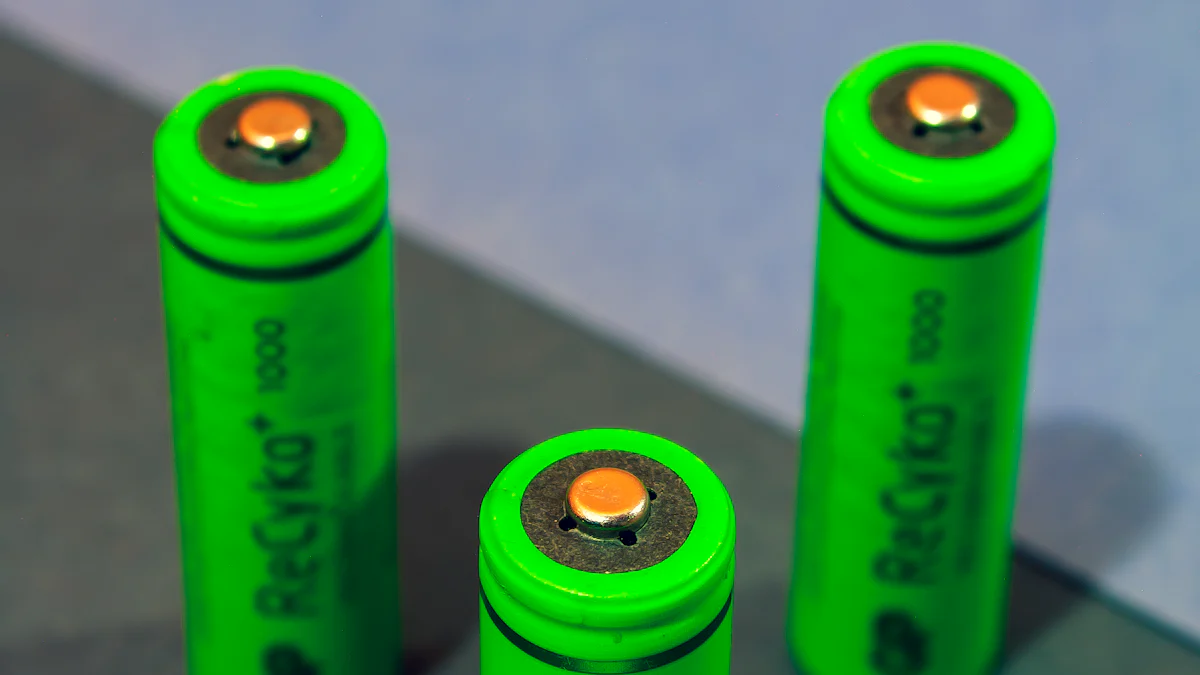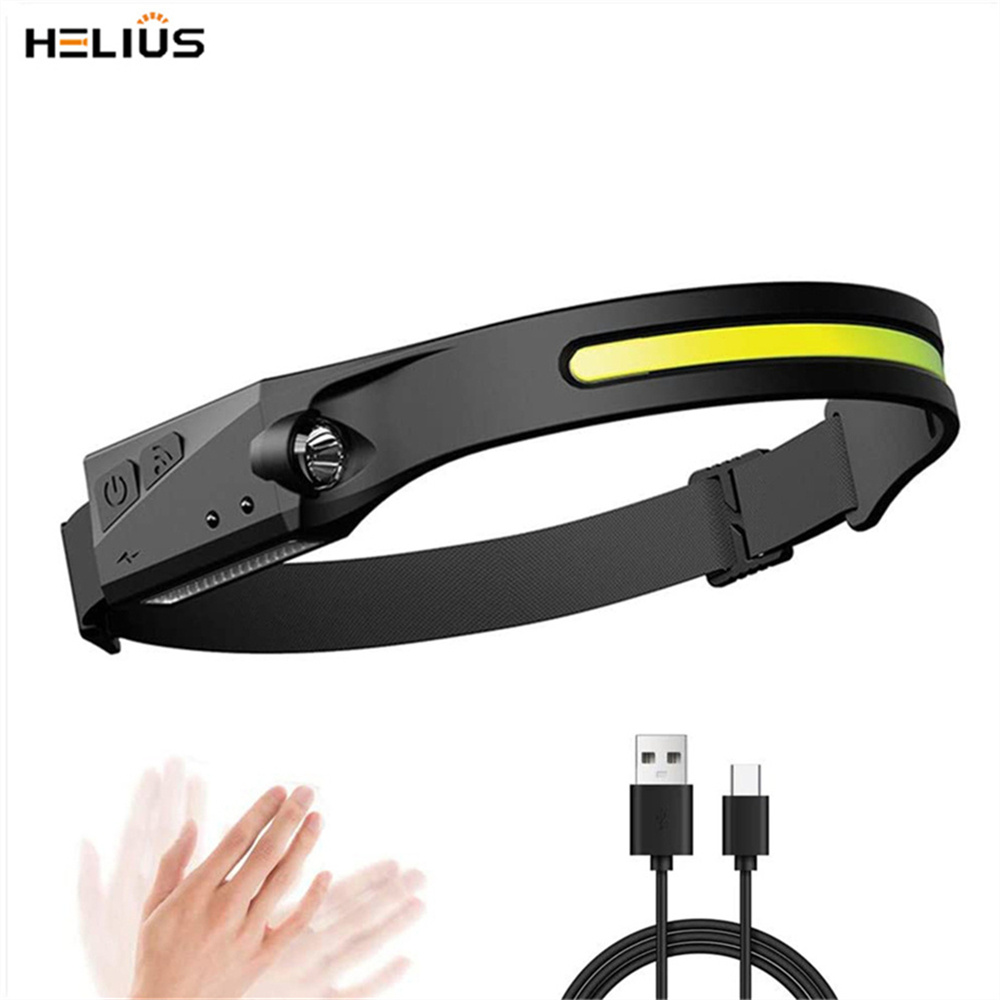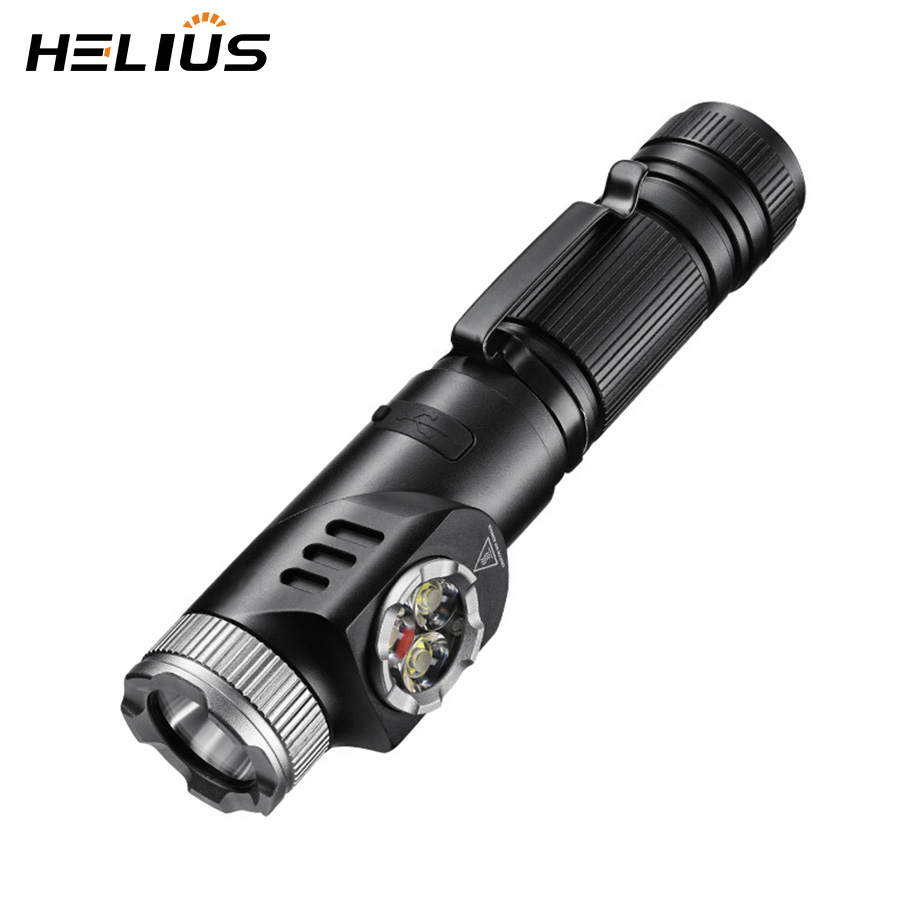Which Flashlight is Better Rechargeable or Disposable Batteries

Choosing between rechargeable vs. disposable battery flashlights: pros and cons depends on your needs. Each option has unique advantages and drawbacks. Rechargeable flashlights save money over time and reduce waste. They can be reused hundreds or thousands of times, conserving resources and lowering carbon emissions. On the other hand, disposable battery flashlights offer convenience and reliability in emergencies. Their single-use nature contributes to landfill overflow and releases harmful chemicals into the environment. Understanding the rechargeable vs. disposable battery flashlights: pros and cons will help you find the best flashlight for your lifestyle.
Key Takeaways
Rechargeable flashlights save money over time. You can use them many times, which makes them cheaper for people who use flashlights a lot.
Flashlights with disposable batteries are great for emergencies. They work right away without charging, so they’re helpful during blackouts.
Using rechargeable flashlights is better for the planet. They make less trash and keep bad chemicals out of dumps, helping the environment.
Think about how you’ll use the flashlight. Rechargeable ones are best if you use them often. Disposable ones are good for rare use or if you want to spend less now.
Look at the total cost. Rechargeable flashlights cost more at first, but they save money later since you don’t need to keep buying batteries.
Pros and Cons of Rechargeable Flashlights

Pros of Rechargeable Flashlights
Cost-effectiveness over time
Rechargeable flashlights are more cost-effective in the long run. While their initial price may seem high, they save you money over time. Rechargeable batteries can be reused hundreds or even thousands of times. This reduces the need to buy disposable batteries repeatedly. For example, a business using 100 flashlights could save thousands of dollars annually by switching to rechargeable options.
Rechargeable batteries can be charged multiple times, lowering costs.
The upfront cost is offset by long-term savings.
A comparison shows that rechargeable flashlights have a higher initial cost but are cheaper over time.
Aspect | Rechargeable Flashlights | Disposable Batteries |
|---|---|---|
Initial Cost | Higher | Lower |
Lifespan of Battery | Up to 1,000 charges | 24 hours per set |
Long-term Cost | Cheaper | More expensive over time |
Environmentally friendly option
Rechargeable flashlights are an eco-friendly and sustainable choice. They reduce waste by eliminating the need for disposable batteries. This helps keep harmful chemicals like lead and mercury out of landfills. Over time, rechargeable flashlights generate significantly less waste, making them a better option for the environment.
They minimize landfill waste.
They reduce the release of harmful chemicals.
Their reusable design supports sustainability.
Pros of small rechargeable batteries for frequent use
Small rechargeable batteries are ideal for frequent use. They are lightweight and easy to recharge. If you use flashlights daily, these batteries provide a reliable and convenient power source. LED rechargeable torches, for instance, often use small rechargeable batteries, offering consistent performance without frequent replacements.
Perfect for daily flashlight users.
Lightweight and easy to handle.
Provide consistent power for frequent use.
Cons of Rechargeable Flashlights
Higher upfront cost
Rechargeable flashlights require a higher initial investment. This can be a drawback if you are on a tight budget. However, the long-term savings often outweigh this initial expense.
Dependence on external power sources
You need access to a power source to recharge your batteries. This can be inconvenient during power outages or in remote areas. If you forget to charge your flashlight, it may leave you unprepared in emergencies.
Limited lifespan of rechargeable batteries
Rechargeable batteries have a finite lifespan. Over time, their capacity decreases, requiring replacement. For instance, lithium-ion batteries used in flashlights can last up to 650 hours, but their performance diminishes with age.
Battery Type | Average Lifespan (Hours) |
|---|---|
Alkaline | 1 – 7 |
Lithium-ion (18650) | Up to 650 |
Zinc Chloride | ~55 |
This limitation highlights one of the cons of small rechargeable batteries, especially for users who rely on flashlights for extended periods.
Pros and Cons of Disposable Battery Flashlights
Pros of Disposable Battery Flashlights
Lower initial cost
One of the main advantages of aa battery-powered flashlights is their affordability. These flashlights have a lower upfront cost compared to rechargeable options. If you need a flashlight for occasional use, this cost-saving feature makes them an attractive choice. The average price difference between non-rechargeable flashlights and rechargeable ones is $10-$15 per unit. For those on a tight budget, this can make a significant difference.
Non-rechargeable flashlights are budget-friendly.
They are ideal for infrequent use.
Widely available aa battery-powered flashlights
Another advantage of aa battery-powered flashlights is their widespread availability. You can find these flashlights and their batteries in almost any store. This makes them a convenient option, especially when you need a quick replacement. The universal compatibility of aa batteries ensures you can power your flashlight without hassle.
AA flashlights are easy to find in stores.
Their batteries are compatible with many devices.
Ideal for emergency situations
Disposable battery flashlights are reliable in emergencies. They do not require charging, so you can store them for long periods without worrying about battery depletion. This makes them a dependable choice for power outages or natural disasters. Unlike rechargeable flashlights, which need regular charging, aa flashlights are ready to use whenever you need them.
Perfect for emergencies like power outages.
No need to recharge before use.
Cons of Disposable Battery Flashlights
Higher long-term cost
While aa flashlights have a lower initial cost, their long-term expenses can add up. Frequent battery replacements make them more expensive over time. If you use your flashlight regularly, the cost of disposable batteries can exceed $200 per year per flashlight. This makes rechargeable options a better investment for frequent users.
Environmental concerns due to waste
One of the major disadvantages of aa battery-powered flashlights is their environmental impact. Improper disposal of disposable batteries can lead to soil and water contamination. Chemicals like lead, mercury, and cadmium from these batteries pose health risks to humans and wildlife. Additionally, lithium batteries can cause landfill fires, releasing harmful gases into the atmosphere.
Disposable batteries contribute to environmental pollution.
Their chemicals can harm ecosystems and human health.
Frequent battery replacement inconvenience
Another drawback of non-rechargeable flashlights is the need for constant battery replacement. This can be inconvenient, especially if you rely on your flashlight daily. Running out of batteries during emergencies can leave you unprepared. In contrast, rechargeable flashlights offer longer battery life and consistent performance.
Frequent replacements disrupt convenience.
Running out of batteries can be problematic in emergencies.
Key Factors to Consider
Cost
Upfront vs. long-term expenses
When choosing between rechargeable flashlights and those powered by disposable batteries, you should weigh the upfront cost against long-term expenses. Rechargeable flashlights may seem expensive initially, but they offer long-term cost savings.
Rechargeable flashlights are a one-time investment. Over time, they become cheaper because you can recharge the batteries hundreds of times.
Disposable batteries, while affordable upfront, require frequent replacements. This adds up, especially if you use your flashlight regularly.
Disposable batteries also have a limited shelf life. They can leak harmful chemicals, making them less reliable for emergencies.
Battery replacement costs
The cost of replacing disposable batteries can quickly exceed the price of a rechargeable flashlight. For example:
A disposable flashlight typically uses two alkaline batteries.
If you use it for 10 minutes daily, you’ll need to replace the batteries monthly.
Over a year, this adds up to 24 battery replacements, significantly increasing costs.
Rechargeable flashlights eliminate this recurring expense, making them a better choice for frequent users.
Convenience
Charging vs. replacing batteries
Rechargeable flashlights offer convenience by eliminating the need for constant battery replacements. You can recharge them using USB ports, solar panels, or wall outlets. Solar rechargeable flashlights are especially useful for outdoor activities or emergencies where power sources are limited.
However, rechargeable batteries require proper maintenance. Issues like self-discharge or parasitic drain can occur if you don’t store them correctly. Extreme temperatures can also affect their performance.
Availability of power sources
The availability of power sources plays a key role in determining convenience. Solar rechargeable flashlights are ideal for situations where traditional power sources are unavailable. They allow you to recharge using renewable energy, reducing waste and supporting sustainability. This makes them practical for eco-conscious users and those in remote areas.
Environmental Impact
Waste generated by disposable batteries
Disposable batteries contribute significantly to landfill waste. Improper disposal can release harmful chemicals like lead and mercury into the environment. These substances contaminate soil and water, posing risks to ecosystems and human health.
Sustainability of rechargeable options
Rechargeable flashlights are better for the environment. Their batteries can be recycled, recovering valuable metals and reducing the need for new mining. While rechargeable batteries contain toxic elements like cadmium and cobalt, recycling mitigates their environmental impact. In contrast, disposable batteries are often discarded after one use, wasting resources and increasing landfill contributions.
By choosing rechargeable flashlights, you support sustainability and reduce your ecological footprint.
Performance
Battery life and runtime
When choosing a flashlight, battery life and runtime are critical factors. Rechargeable flashlights often provide a long-lasting battery life, making them ideal for extended use. Their rechargeable batteries can deliver consistent power for hours, depending on the model and usage. For example, a high-quality rechargeable flashlight with lithium-ion batteries can run for up to 10 hours on a single charge. This makes them suitable for activities like camping or working in low-light conditions.
Disposable battery flashlights, on the other hand, depend on the capacity of their alkaline or zinc-carbon batteries. These flashlights typically offer shorter runtimes compared to rechargeable options. For instance, an AA-powered flashlight may last only a few hours before requiring new batteries. If you use flashlights frequently, the shorter runtime of disposable batteries can become inconvenient and costly.
Flashlight Type | Average Runtime (Hours) |
|---|---|
Rechargeable Flashlights | 5–10 (per charge) |
Disposable Flashlights | 2–5 (per battery set) |
Reliability in different scenarios
The reliability of a flashlight depends on its ability to perform under various conditions. Rechargeable flashlights excel in rugged environments. Many models feature durable materials, water-resistant designs, and impact-resistant casings. These features ensure they function even in heavy rain, extreme temperatures, or after accidental drops. For outdoor adventures or harsh weather, rechargeable flashlights provide dependable performance.
Disposable battery flashlights are also reliable but in different ways. They do not rely on external power sources, making them ready to use at any time. This makes them a practical choice for emergencies like power outages or natural disasters. However, their performance may decline in extreme conditions. Alkaline batteries, for example, can lose efficiency in very cold or hot temperatures.
If you need a flashlight for demanding environments, rechargeable flashlights with high lumen outputs and robust designs are a better choice. For occasional use or emergencies, disposable options offer convenience and immediate availability.
Comparison Table

Quick Overview of Key Differences
Cost comparison
When comparing costs, rechargeable flashlights stand out as a long-term investment. They typically cost $10-$15 more upfront than flashlights powered by disposable batteries. However, their ability to recharge hundreds of times saves you money over time. For instance, if you replace disposable batteries weekly, you could save over $200 per flashlight in the first year alone. This makes rechargeable options ideal for frequent users or facilities with multiple lights. On the other hand, disposable battery flashlights are more affordable initially, making them suitable for occasional use or tight budgets.
Convenience comparison
Rechargeable flashlights offer unmatched convenience for regular use. You can recharge them using USB ports, solar panels, or wall outlets, eliminating the need for constant battery replacements. This feature is especially useful for daily users or those in remote areas. However, they rely on access to power sources, which can be a drawback during outages. Flashlights with disposable batteries, in contrast, are always ready to use. Their batteries are widely available, making them a practical choice for emergencies or situations where charging isn’t possible.
Environmental impact comparison
Rechargeable flashlights significantly reduce waste. Their batteries can be reused hundreds or thousands of times, minimizing the need for new manufacturing. This helps lower your carbon footprint and supports sustainability. Disposable batteries, however, often end up in landfills, where they release harmful chemicals like lead and mercury. These substances can contaminate soil and water, posing risks to ecosystems and human health. By choosing rechargeable options, you contribute to a cleaner environment and reduce the strain on natural resources.
Performance comparison
Rechargeable flashlights excel in performance, offering longer runtimes and consistent power. High-quality models can run for up to 10 hours on a single charge, making them ideal for extended use. Their durable designs also ensure reliability in harsh conditions. Disposable battery flashlights, while dependable for emergencies, have shorter runtimes. Alkaline batteries may last only a few hours before needing replacement. If you need a flashlight for demanding environments or frequent use, rechargeable options provide better performance and durability.
Both rechargeable and disposable battery flashlights have unique strengths. Rechargeable flashlights work best for frequent use, offering long-term savings and reducing waste. They save you money by eliminating recurring battery costs and help protect the environment by minimizing harmful chemicals in landfills. On the other hand, flashlights with disposable batteries are ideal for emergencies or occasional use due to their affordability and immediate availability. Your choice should depend on your budget, how often you use flashlights, and your environmental priorities.
FAQ
What is the main difference between rechargeable and disposable flashlights?
Rechargeable flashlights use batteries that can be recharged multiple times, saving money over time. Flashlights with disposable batteries rely on single-use batteries, which need frequent replacement. Your choice depends on how often you use the flashlight and your budget.
Are rechargeable flashlights better for the environment?
Yes, rechargeable flashlights reduce waste by reusing batteries hundreds of times. This minimizes landfill contributions and lowers harmful chemical emissions. Disposable batteries, on the other hand, often end up in landfills, causing environmental harm.
Can I use rechargeable flashlights during emergencies?
Rechargeable flashlights work well in emergencies if they are fully charged. However, they depend on power sources for recharging. Disposable battery flashlights are more reliable for emergencies since they don’t require charging and can be stored for long periods.
How long do rechargeable batteries last compared to disposable ones?
Rechargeable batteries can last up to 1,000 charge cycles, providing consistent power for years. Disposable batteries typically last only a few hours of use before needing replacement. For frequent use, rechargeable options are more cost-effective and reliable.
Which flashlight is better for occasional use?
For occasional use, flashlights with disposable batteries are more practical. They have a lower upfront cost and are ready to use without charging. Rechargeable flashlights are better suited for frequent use due to their long-term savings and reduced waste.
See Also
Rechargeable Or Traditional Flashlights: Which One Reigns Supreme?
Enhancing Efficiency: Selecting Top Batteries For Bulk Flashlights
Finding The Ideal Flashlights For Wholesale Buying
Selecting Optimal LED Flashlights For Bulk Acquisition
Comprehensive Guide To Wholesale Flashlights: Batteries And Brightness
About US
Follow Us
Hello,Friend,
I am Mary from Helius, we are manufacturer of LED lighting products with more than a decade of experiences.
We offer hot selling products in market and guarantee the quality with competitive cost.
Let’s have more discussion on your inquiry.
Or you can reach out me via what’s up/tele gram +8618123952945 if it’s favorable to you.
Address
4th Floor, Building A16, Intelligent terminal industrial park of Silicon Valley, Dafu Industrial Zone,Guanlan, Shenzhen, 518110 China
Contacts
mary@heliuslights.com
heliuslight04@hotmail.com
+0086 18123952945
